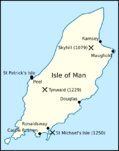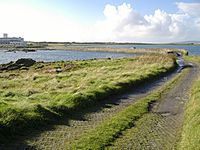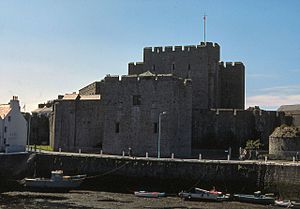Magnús Óláfsson facts for kids
Quick facts for kids Magnús Óláfsson |
|
|---|---|
| King of Mann and the Isles | |

Magnús' name and title as it appears on folio 49r. of British Library Cotton MS Julius A VII (the Chronicle of Mann): magnus rex manniæ et insularum.
|
|
| King of Mann and the Isles | |
| Reign | 1254–1265 |
| Predecessor | Haraldr Guðrøðarson |
| Successor | Manx monarchy abolished |
| Died | 24 November 1265 Castle Rushen |
| Burial | Abbey of St Mary of Rushen |
| Spouse | Máire Nic Dubhghaill |
| Issue | Guðrøðr Magnússon |
| House | Crovan dynasty |
| Father | Óláfr Guðrøðarson |
Magnús Óláfsson (died 24 November 1265) was the last King of Mann and the Isles. He was a son of Óláfr Guðrøðarson, who was also a King of the Isles. Magnús was part of the Crovan dynasty, a powerful family that ruled the Isle of Man (Mann) and parts of the Hebrides islands.
Even though they were kings, the Crovan rulers like Magnús also paid tribute to the Kings of Norway. This meant they accepted Norway as their overlord. Magnús's rule ended when he was forced to submit to King Alexander III of Scotland.
Contents
Becoming King of Mann
In 1237, Magnús's father, Óláfr, passed away. His older brother, Haraldr, became king but later drowned in 1248. After Haraldr, another brother, Rǫgnvaldr, became king for only a few weeks before he was killed.
Then, Haraldr Guðrøðarson, a distant relative, took the throne. But the King of Norway, Hákon Hákonarson, removed him from power. While Haraldr was away, Magnús and his relative, Eóghan Mac Dubhghaill, tried to take over Mann but failed. A few years later, Magnús successfully returned to the island and was named king.
| Simplified family tree showing Magnús's family and rivals. | ||||||||||||||||||||||||||||||||||||||||||||||||||||||||||||||||||||||||||||||||||||||||||||||||||||||||||||||||||||||||||||||||||||||||||||||||||||||||||||||||||||||||||||||||||||||||||||||||||||||||||||||||||||||||||||||||||||||||||||||||||||||||||||||||||||||||||||||||||||||||||||||||||||||||||||||||||||||||||||||||||||||||||||||||||||||||||||||||||||||||||||||||||||||||||||||||||||||||||||||||||||||||||||||||||||||||||||||||||||||||||||||||||||||||
|---|---|---|---|---|---|---|---|---|---|---|---|---|---|---|---|---|---|---|---|---|---|---|---|---|---|---|---|---|---|---|---|---|---|---|---|---|---|---|---|---|---|---|---|---|---|---|---|---|---|---|---|---|---|---|---|---|---|---|---|---|---|---|---|---|---|---|---|---|---|---|---|---|---|---|---|---|---|---|---|---|---|---|---|---|---|---|---|---|---|---|---|---|---|---|---|---|---|---|---|---|---|---|---|---|---|---|---|---|---|---|---|---|---|---|---|---|---|---|---|---|---|---|---|---|---|---|---|---|---|---|---|---|---|---|---|---|---|---|---|---|---|---|---|---|---|---|---|---|---|---|---|---|---|---|---|---|---|---|---|---|---|---|---|---|---|---|---|---|---|---|---|---|---|---|---|---|---|---|---|---|---|---|---|---|---|---|---|---|---|---|---|---|---|---|---|---|---|---|---|---|---|---|---|---|---|---|---|---|---|---|---|---|---|---|---|---|---|---|---|---|---|---|---|---|---|---|---|---|---|---|---|---|---|---|---|---|---|---|---|---|---|---|---|---|---|---|---|---|---|---|---|---|---|---|---|---|---|---|---|---|---|---|---|---|---|---|---|---|---|---|---|---|---|---|---|---|---|---|---|---|---|---|---|---|---|---|---|---|---|---|---|---|---|---|---|---|---|---|---|---|---|---|---|---|---|---|---|---|---|---|---|---|---|---|---|---|---|---|---|---|---|---|---|---|---|---|---|---|---|---|---|---|---|---|---|---|---|---|---|---|---|---|---|---|---|---|---|---|---|---|---|---|---|---|---|---|---|---|---|---|---|---|---|---|---|---|---|---|---|---|---|---|---|---|---|---|---|---|---|---|---|---|---|---|---|---|---|---|---|---|---|---|---|---|---|---|---|---|---|---|---|---|---|---|---|---|---|---|---|---|---|---|---|---|---|---|---|---|---|---|---|---|---|---|---|---|---|---|---|---|---|---|---|---|---|---|---|---|---|---|---|---|---|---|---|---|---|---|---|---|---|---|---|---|---|---|
|
||||||||||||||||||||||||||||||||||||||||||||||||||||||||||||||||||||||||||||||||||||||||||||||||||||||||||||||||||||||||||||||||||||||||||||||||||||||||||||||||||||||||||||||||||||||||||||||||||||||||||||||||||||||||||||||||||||||||||||||||||||||||||||||||||||||||||||||||||||||||||||||||||||||||||||||||||||||||||||||||||||||||||||||||||||||||||||||||||||||||||||||||||||||||||||||||||||||||||||||||||||||||||||||||||||||||||||||||||||||||||||||||||||||||
Struggles with Scotland and Norway
The kings of Scotland wanted to control the Isles. In the 1240s, Alexander II, King of Scots tried to buy the Isles from Norway. When that didn't work, he tried to take them by force. His death in 1249 stopped his plans.
Years later, in 1261, Alexander II's son, Alexander III, also tried to buy the Isles. When negotiations failed, Scottish forces attacked the Hebrides.
Norway's Response
In response to Scotland's attacks, King Hákon of Norway gathered a huge fleet. He wanted to show Norway's power in the region. In the summer of 1263, his fleet sailed through the Hebrides. Magnús was one of the few local rulers who fully supported Hákon.
During this time, Hákon sent Magnús and other leaders to raid deep into Lennox in Scotland. Meanwhile, the main Norwegian force fought the Scots in the Battle of Largs. This was a famous but not very decisive series of small fights.
After the Battle of Largs, Hákon's fleet returned home without achieving much. Soon after, Hákon died. King Alexander III of Scotland then launched attacks on the Hebrides and threatened Mann. Magnús had no choice but to surrender to the Scottish king. He promised loyalty and gave up his lands. This showed that Norway's power in the Isles had completely ended.
The End of a Dynasty
Magnús, the last ruling king of his family, died at Castle Rushen on November 24, 1265. He was buried at the Abbey of St Mary of Rushen. At the time of his death, he was married to Máire, Eóghan's daughter.
His death marked the end of the "golden age" of Scandinavian sea-kings on the Isle of Man. One year after his death, Norway officially gave the Hebrides and Mann to the King of Scots.
The Kingdom is Divided
In 1266, the Treaty of Perth was signed. This agreement finally settled the long dispute between Norway and Scotland over the western islands. King Magnús Hákonarson of Norway gave the Hebrides and Mann to King Alexander III of Scotland. Scotland agreed to pay a large sum of money for them.
The treaty also said that the people of the islands would follow Scottish laws. They would not be punished for their past actions and could choose to stay or leave their homes peacefully.
In 1275, Guðrøðr Magnússon, Magnús Óláfsson's son, tried to become king on Mann. He led a revolt, but Scottish forces quickly crushed it at the Battle of Ronaldsway. Guðrøðr was likely killed in the battle. The Isle of Man then became part of the Kingdom of Scotland.
By the late 1200s, the islands that Magnús and his family once ruled were fully part of Scotland. New areas called sheriffdoms were created to govern them.
Images for kids







